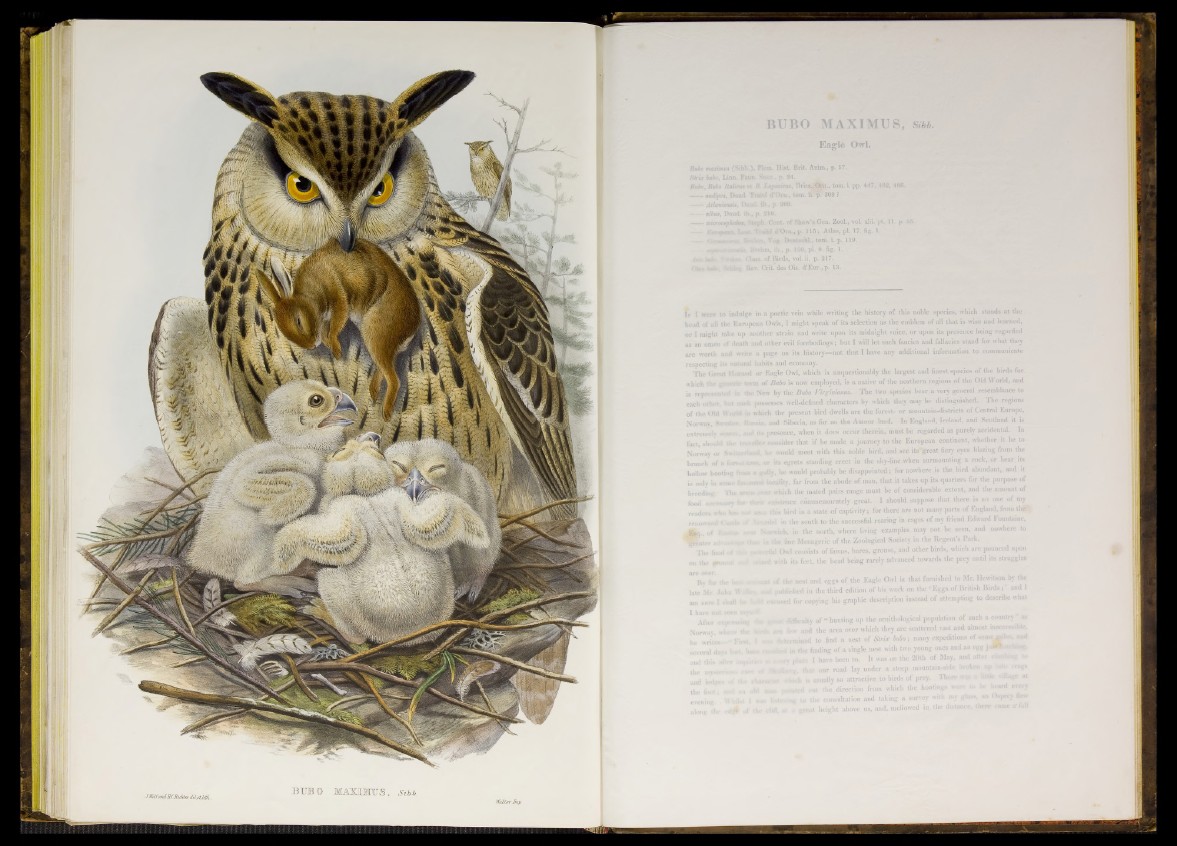
BUBO MAXIMUS, Sibh.
Eagle Owl.
ximus (Stbb.), Flem. Hist. Brit. Anim., p. 67.
'to, Linn. Faun. Saec., p. 24.
ibo Italicas et B. Briss..Orn., tom. i. pp. 447, 482, 486.
lipes, Baud. Trriti d’Orn., tom. ii?p.' 209 ?
us, Baud, ib., p. 210.
wocephalvf.. Steph Cent, of Shaw’s Gen. Zool., vol. riii. pt. 11. p.
n-Tpnnff.. Lfc*« i'svufe d'Orn., p. 115; Atlas, pi. 17. fig. 1.
ifevhra, Yog. DeutschL, tom. i. p. 119.
Breiuu, ib., p. 120, pL 9. fig. 1.
Swaim. Class, of Birds, vol. u. p. 217.
k . --Vhu-i- Rev. C rit des Ois. d’Eur.,p. 13.
a poetic vein while writing the history o£ this noble species, which stands at the
Owls, I might speak of its selection as the emblem of all that is wise and learned,
ler strain and write upon its midnight voice, or upou its presence being regarded
other evil forebodings; but I will let such fancies and fallacies stand for what they
jage on its history—not that 1 have any additional information to communicate
Eagle Owl, which is unquestionably the largest and finest species o f the birds for.
f Bubo is now employed, is a native of the northern regions of the Old World, and
K Bubo VirgintatM. The two species bear a very general resemblance to
by I
ell-defined characters by which they may be distinguished. The regions
be present bird dwells are the forest- or mouiitain-districts of Central Europe,
d Siberia, as far as the Amoor land. In England, Ireland, and Scotland it is
sence, when it does occar therein, must be regarded as purely accidental. In
wider that if be made a journey to the European continent, whether it be to
would meet with this noble bird, and see its great fiery eyes blazing from the
ts egrets standing erect in the sky-line when surmounting a rock, or hear its
he would probably be disappointed; for nowhere is the bird abundant, and it
branch
is onlv in »on»* favonmi locality, far from the abode o f man, that it takes up its quarters for the purpose of
breeding. Tin- arc ♦* ,v" *>r which the mated pairs range must be o f considerable extent, and the amount of
food necessary for their . • tence commensurately great. I should suppose th at there is no one o f my
readers who this bird in a state of captivity; for there are not many parts of England, from the
renowned < **** of Wwodel in the south to the successful rearing in cages o f my friend Edward Fountaine,
fisq o f Norwich, in the north, where living examples may M l
:rie o f the Zoological Society in the Regent
The food <* «fee» Mwerftti Owl consists of fawns, hares, grouse, and other birds, which are pounced upor
i the : head being rarely advanced towards the prey until i
eggs of the Eagle Owl is tha t furnished to Mr. Hewitsc
• th ird edition o f his work on the ‘Eggs of British Birds
ig his graphic description instead o f attempting to desci
“ hunting up the ornithological population o f such a cot
they a re scattered vast and almost mat
the <
ined to find a nest of Stria? bubo; many expeditions of some i,;
the finding o f a single nest with two young ones and an egg jaW
ace 1 have been to. I t was on the 20th of May, and after cb
that our road lay under a steep mountain-side broken up *
h is usually so attractive to birds o f prey. There *
id out the direction from which the hooting* were to
to the consultation and taking a survey with my glass, an Us
(V hpio-ht above us. and, mellowed in. the distance, there ca